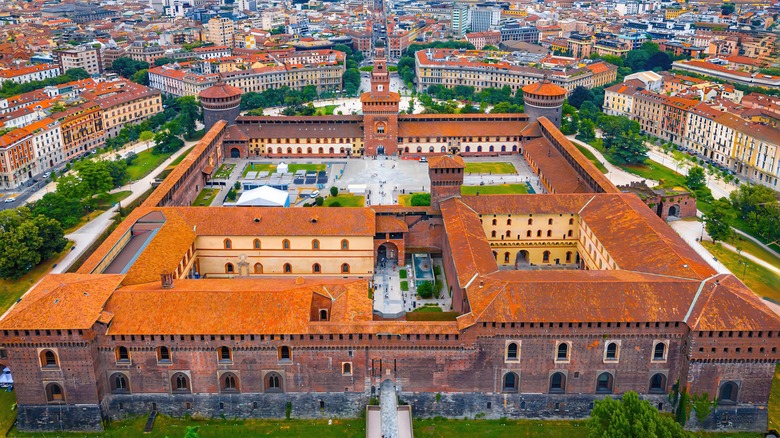Rick Steves Says This Stunning Gem Is 'Italy's Most Underrated City'
Italy is a country so rich in destinations that it can be hard to know where to begin. From beautiful Italian islands and elegant wine regions, to gorgeous, under-the-radar towns, the sheer amount of enthralling places to visit can be dizzying. This is especially true for Italy's major cities. Sure, you may want to see them all during a single visit, but time, logistics, and budgets make this an impossibility. This means you have to make some difficult choices — do you want to pass your days wandering the historic streets of Rome, or getting down with fresh seafood and authentic pizza in Naples? Do you wish to spend the lion's share of your time soaking up the amazing art and architecture of Florence, or does a romantic gondola ride in Venice float your boat?
While any of these cities are sure to scratch your itch for Italian culture, according to European travel guru Rick Steves, one place in particular is worthy of your attention: Milan. Situated in the country's far north, Milan is Italy's long-time financial center, and while it may lack the obvious romance of some of the country's other towns, the city boasts its own unique charms.
"They say that for every church in Rome, there's a bank in Milan," Steves wrote on his website. "Indeed, the economic success of postwar Italy can be attributed, at least in part, to this second city of bankers, publicists, and pasta power-lunchers. While overshadowed by Venice, Florence, and Rome in the minds of travelers, Milan still has plenty to offer anyone who visits." He then went on to describe Milan as "Italy's most underrated city."
Discover the grand splendors of Milan
Milan's history dates back to 600 B.C., and later it was the capital of the Western Roman Empire. Modern Milan, however, owes much of its success to the Renaissance, when the flourishing city was labeled "the New Athens." Modern Milan's financial prowess grew even more in the wake of World War II, when the city assumed the mantle of Italy's banking and industrial center.
That said, there's much more to Milan than business and materialistic pursuits. Like any great Italian burg, the city is home to a glorious cathedral known as the Duomo di Milano. Rising like an exquisite mountain in the very heart of the city, the cathedral is a massive affair clearly intended to inspire awe, though perhaps its greatest beauty lies in the detailed work that can only be appreciated from up close. "Marveling at countless ornaments carved more than five centuries ago in marble — each flower, each gargoyle, each saint's face different — I realize the public was never intended to see this art," Rick Steves wrote. "An expensive labor of love, it was meant for God's eyes only."
After exploring the nooks and crannies of the city's great church, make sure to soak up the local splendor at the Piazza del Duomo. This great square sits right in front of the cathedral and is the perfect spot to relax and observe the ultra-fashionable locals doing their thing. While you're there, head over to the Basilica di Santa Maria delle Grazie, where the walls are graced by Leonardo da Vinci's masterpiece "The Last Supper," before wandering through the halls of Castello Sforzesco. This 15th-century structure is famous for its red brick and home to several municipal museums well worthy of your time.
Art, architecture, and food in Milan
Of course, no trip to Italy's great northern metropolis is complete without a visit to Teatro alla Scala. Also known as La Scala, this grand opera house may look a bit plain from the outside, but once you walk through its arched doors, you will find a rich world that is a triumph of neoclassical design. While its walls (and excellent museum) breathe history, this is a working venue where viewing a performance won't necessarily break the bank. "Like other great opera houses in Europe," Rick Steves wrote, "La Scala makes sure that impoverished music lovers can get standing-room tickets or nose-bleed seats that go on sale the day of the performance."
It goes without saying that art lovers will find no shortage of treasures in Milan. Gallerie d'Italia arguably houses the city's greatest collection, featuring nearly 9,000 square feet of renowned works across the 19th and 20th centuries. For a more modern perspective, check out the dazzling Fondazione Prada, a refurbished gin distillery that now hosts art and design exhibitions, concerts, films, and more. Palazzo Reale features marquee-name painters and photographers connected to the city's rich fashion scene, while every April, Salone del Mobile exhibits and attracts the biggest names in furniture design.
For the consummate Milan experience, be sure to experience "aperitivo." This is a local custom where bars and restaurants offer drinks and small-plate snacks between the hours of roughly 5 p.m. and 8 p.m., as most Milanese don't sit down for dinner until later in the evening. It's an ideal way to unwind after a day of wandering the city's historic streets, a time to slow down and appreciate what an extraordinary place you find yourself in. Milan is served internationally by Malpensa Airport (MXP). From there, it's a 50-minute express train ride to Milano Centrale station.


